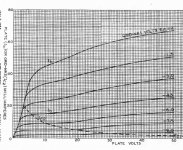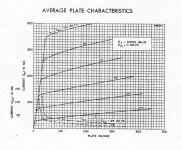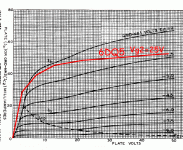There's an excellent article on this topic by Quan Ronald in Linear Audio volume 10.
They can be used and actually preamp is the only 'real' application for them since none of them are capable of big output numbers. You can get some output with the power tetrode units but it won't be very loud unless you use high voltage finals or SS buffer(which is the best option TBH).
I'm working on a schematic for a 12AJ6 stereo phono preamp but without my shop and some experimentation I'm not sure how linear I can get them.
The nice thing about these low-voltage tubes is they're cheap and you can safely experiment with them using standard silicon parts like an LM317 without any worry.
I'm working on a schematic for a 12AJ6 stereo phono preamp but without my shop and some experimentation I'm not sure how linear I can get them.
The nice thing about these low-voltage tubes is they're cheap and you can safely experiment with them using standard silicon parts like an LM317 without any worry.
Tubes with higher heater demands are usually better suited for low-voltage duty. The 5687 is a good example as is the 5814A. The 12U7 low-voltage dual triode is just a specially tested 12AU7.
I can confirm the 6922 as I have a hybrid headphone amp that uses a 6922 with CCS plate load that runs on only 24V and was my daily driver for years. Haven't tried the 6N23P in that guy yet...
I can confirm the 6922 as I have a hybrid headphone amp that uses a 6922 with CCS plate load that runs on only 24V and was my daily driver for years. Haven't tried the 6N23P in that guy yet...
They can be used and actually preamp is the only 'real' application for them since none of them are capable of big output numbers. You can get some output with the power tetrode units but it won't be very loud unless you use high voltage finals or SS buffer(which is the best option TBH).
I'm working on a schematic for a 12AJ6 stereo phono preamp but without my shop and some experimentation I'm not sure how linear I can get them.
The nice thing about these low-voltage tubes is they're cheap and you can safely experiment with them using standard silicon parts like an LM317 without any worry.
Thank you I look forward to seeing what you come up with on the phono preamp so please post.
12AJ6
I've experimented with spacecharge tubes for quite a while. 12AJ6 is NOT a hi-fi tube, it has a significant midrange bump and low frequency rolloff. Out of all preamp tubes I'vetried I'd say 12DV7 is the most hi-fi, while is's till far from being as hi-fi as 12AX7 and such.
Here's a list of the tubes with my impressions about their sound in a neutral circuit:
12AJ6 - grainy, not much lows, midrange bump, fuzzy, good for guitar.
12FM6 - less gain, lezz fuzz, still not much low end.
12DU7 - 9-pin, way more lows than the rest of the pack. less midrange bump.
ECH83 6V triode-heptode, both are suitable for audio use, no lows, lots of middle. lo-fi sound.
12BF6 - similar to 12AJ6 with even more midrange bump. good for guitar.
I've experimented with spacecharge tubes for quite a while. 12AJ6 is NOT a hi-fi tube, it has a significant midrange bump and low frequency rolloff. Out of all preamp tubes I'vetried I'd say 12DV7 is the most hi-fi, while is's till far from being as hi-fi as 12AX7 and such.
Here's a list of the tubes with my impressions about their sound in a neutral circuit:
12AJ6 - grainy, not much lows, midrange bump, fuzzy, good for guitar.
12FM6 - less gain, lezz fuzz, still not much low end.
12DU7 - 9-pin, way more lows than the rest of the pack. less midrange bump.
ECH83 6V triode-heptode, both are suitable for audio use, no lows, lots of middle. lo-fi sound.
12BF6 - similar to 12AJ6 with even more midrange bump. good for guitar.
Are you saying that the 12AJ6 has significant internal resonances in the audio range? If not, it cannot have a bump or a rolloff - circuits have bumps and rolloffs, valves work from DC to VHF. Of course, the distortion produced by a valve+circuit may give the impression of frequency response problems, or the circuit may be inappropriate for that valve.engels said:12AJ6 is NOT a hi-fi tube, it has a significant midrange bump and low frequency rolloff.
The 12DU7 is the only one on your list that is a true space-charge tube and the only one that could actually run a next-stage load. Those other low-voltage triodes are just that. Similar tubes to the 12DU7 are 12DK7, 12DL8, 12DS7, 12DU7, 12DV7, 12DV8, and the 12K5(no diodes). You can drive headphones with these via output transformer for 16/32 ohm loads.
What circuit are you using for the tubes under test? The 12AJ6, for example, typically operates with 750uA of anode current which is TINY and you need to make sure your next stage isn't loading it at all. Datasheet says a 1 meg anode resistor at 12.6V, a 0.01uF output capacitor, and a 2 meg grid resistance for the next stage. 8hz cutoff frequency for that setup so no excuse for a lack of bass.
What circuit are you using for the tubes under test? The 12AJ6, for example, typically operates with 750uA of anode current which is TINY and you need to make sure your next stage isn't loading it at all. Datasheet says a 1 meg anode resistor at 12.6V, a 0.01uF output capacitor, and a 2 meg grid resistance for the next stage. 8hz cutoff frequency for that setup so no excuse for a lack of bass.
Last edited:
Been looking for decently priced 6GM8s for a while now. I've managed to find one at my local surplus store. Hopefully some new tubes they plan to be bringing in soon will have a couple. I haven't played with mine yet but it's on the list when I get back to low-voltage stuff.
If you can get a matching quad or two pairs and want to build a line stage consider the Broskie 12Vac Aikido board. This normally uses a 12 volt transformer with 6DJ8s or an 18 volt with 12AU7s. The 6GM8s draw a little less filament current than a 6DJ8 so you can use a 9 volt trans.
Some years ago people were almost giving away 6GM8s but then they were "discovered" and the price went crazy. I got a bunch of mine when they were reasonable. I needed a line stage for a second system so I put some GMs and a 9 volt torroid I had kicking around to work.
To modify the Broskie board for 6GM8s do the following:
R2 and R4= 220 ohms, R8 and R11= 160 ohms, R13= 75K ohms.
You will need to select the filament dropping resistor (R15) depending on the transformer you choose. I used a Talema TE70061 from Digikey and a 6.8 ohm, 3 watt resistor did the trick.
For the B+ dropping resistor (R12) an 1800 ohm yielded 46 volts filtered B+ for the tubes. This might seem a little high for 6GM8s but as the Aikido circuit "stacks" the tubes each triode only "sees" 23 volts. The resistors I used for R2, 4, 8, 11 got the tubes cooking but still keeps them at a fairly low percentage of their max dissipation.
The sound: Kickass
In a recent Broskie blog he describes how using "regular" tubes with low B+ and reducing the filament voltage yields better sound.
Cheers
Some years ago people were almost giving away 6GM8s but then they were "discovered" and the price went crazy. I got a bunch of mine when they were reasonable. I needed a line stage for a second system so I put some GMs and a 9 volt torroid I had kicking around to work.
To modify the Broskie board for 6GM8s do the following:
R2 and R4= 220 ohms, R8 and R11= 160 ohms, R13= 75K ohms.
You will need to select the filament dropping resistor (R15) depending on the transformer you choose. I used a Talema TE70061 from Digikey and a 6.8 ohm, 3 watt resistor did the trick.
For the B+ dropping resistor (R12) an 1800 ohm yielded 46 volts filtered B+ for the tubes. This might seem a little high for 6GM8s but as the Aikido circuit "stacks" the tubes each triode only "sees" 23 volts. The resistors I used for R2, 4, 8, 11 got the tubes cooking but still keeps them at a fairly low percentage of their max dissipation.
The sound: Kickass
In a recent Broskie blog he describes how using "regular" tubes with low B+ and reducing the filament voltage yields better sound.
Cheers
Mona Ketje mentioned the 26A7. It's not a space charge tube. More like a TV Sweep tube (rather high heater power) with a small plate for LV operation. Which is a good clue to just using TV Sweep tubes with LV. They typically have a low plate knee voltage and high emission.
pics:
26A7 26.5 V on screen (26.5V at 0.6 Amp heater) (50V max for the screen, so could almost equal the 6DQ5 knee at 50V) (2 Watt max. plate diss.)
6DQ5 Knee curves (6.3V at 2.5 Amp heater) (notice the knee at 140 mA for 50V on the screen) (24 Watts max. plate diss.)
21HB5 will give you 1.5 x the gm1 of the 6DQ5
pics:
26A7 26.5 V on screen (26.5V at 0.6 Amp heater) (50V max for the screen, so could almost equal the 6DQ5 knee at 50V) (2 Watt max. plate diss.)
6DQ5 Knee curves (6.3V at 2.5 Amp heater) (notice the knee at 140 mA for 50V on the screen) (24 Watts max. plate diss.)
21HB5 will give you 1.5 x the gm1 of the 6DQ5
Attachments
Last edited:
I tested some TV Sweep tubes on the curve tracer to see if they really are performing at low voltage as well as their datasheets indicate.
The one Sylvania 6DQ5 I have shows a knee voltage of 30V at 50V on grid2. So not nearly as good as its datasheet indicates: 20V.
Sylvania 21HB5 generally performed similar to that 6DQ5, but I did not see any 1.5X in gm1, about 1X.
An RCA 22KM6 performed a little better than the 6DQ5, still about 30V knee for 50V on grid2, but 160 mA at 50V versus 140 mA for the 6DQ5. 30% higher gm1 too.
24JE6C was similar to the 22KM6.
Most other Sweep tubes had a knee voltage up at 40V to 50V for 50V on grid2.
24LX6 and 36MC6 were good performers, still a 30V knee with 50V on grid2, but an impressive 270 mA at the knee.
So 26A7 is still looking like the best for LV application.
The one Sylvania 6DQ5 I have shows a knee voltage of 30V at 50V on grid2. So not nearly as good as its datasheet indicates: 20V.
Sylvania 21HB5 generally performed similar to that 6DQ5, but I did not see any 1.5X in gm1, about 1X.
An RCA 22KM6 performed a little better than the 6DQ5, still about 30V knee for 50V on grid2, but 160 mA at 50V versus 140 mA for the 6DQ5. 30% higher gm1 too.
24JE6C was similar to the 22KM6.
Most other Sweep tubes had a knee voltage up at 40V to 50V for 50V on grid2.
24LX6 and 36MC6 were good performers, still a 30V knee with 50V on grid2, but an impressive 270 mA at the knee.
So 26A7 is still looking like the best for LV application.
RE: PRR
I guess those are some real measurements on a 6DQ5.
Which look darn good!
I went back and took some curve pics using an expanded 10V/div plate V scale and using both 25V and 50V for the screen grid.
(was using 50Vg2 and 50V/div plate V before, which was hard to see accurately at these low voltages)
I also found a Westinghouse 26DQ5.
One thing I notice is that one can get more current (like 2X) and still a low plate knee V by using a higher (50V) Vg2 with some (like -2V) negative bias on the max plate curve used.
Pics: (all at 10V/div Horiz., -0.6 V steps on grid 1, down from 0V)
1) Westinghouse 26DQ5 25Vg2, 10 mA/div Vert.
2) Westinghouse 26DQ5 50Vg2, 20 mA/div Vert.
3) Sylvania 6DQ5 25Vg2, 10 mA/div Vert.
4) Sylvania 6DQ5 50Vg2, 20 mA /div Vert.
5) Zenith 26LX6 25Vg2, 20 mA/div Vert.
6) Zenith 26LX6 50Vg2, 50 ma/div Vert.
7) Sylvania 21HB5A 25Vg2, 10 mA/div Vert.
8) Sylvania 21HB5A 50Vg2, 20 mA/div Vert.
I'll have to order a couple of 26A7 tubes to check them out now "in the glass".
And, hey, those 21HB5A tubes work good at 25Vg2 too. They used to be $1 each. Great tubes.
Looks like 25Vg2 works much better than 50Vg2 for low knee voltage.
That 26LX6 does take the cake for some real current at 25Vg2. Expensive $$$ tubes though.
I'm gonna re-check a few Sweep tubes at the lower 25Vg2. Probably a few good other types for LV too.
I guess those are some real measurements on a 6DQ5.
Which look darn good!
I went back and took some curve pics using an expanded 10V/div plate V scale and using both 25V and 50V for the screen grid.
(was using 50Vg2 and 50V/div plate V before, which was hard to see accurately at these low voltages)
I also found a Westinghouse 26DQ5.
One thing I notice is that one can get more current (like 2X) and still a low plate knee V by using a higher (50V) Vg2 with some (like -2V) negative bias on the max plate curve used.
Pics: (all at 10V/div Horiz., -0.6 V steps on grid 1, down from 0V)
1) Westinghouse 26DQ5 25Vg2, 10 mA/div Vert.
2) Westinghouse 26DQ5 50Vg2, 20 mA/div Vert.
3) Sylvania 6DQ5 25Vg2, 10 mA/div Vert.
4) Sylvania 6DQ5 50Vg2, 20 mA /div Vert.
5) Zenith 26LX6 25Vg2, 20 mA/div Vert.
6) Zenith 26LX6 50Vg2, 50 ma/div Vert.
7) Sylvania 21HB5A 25Vg2, 10 mA/div Vert.
8) Sylvania 21HB5A 50Vg2, 20 mA/div Vert.
I'll have to order a couple of 26A7 tubes to check them out now "in the glass".
And, hey, those 21HB5A tubes work good at 25Vg2 too. They used to be $1 each. Great tubes.
Looks like 25Vg2 works much better than 50Vg2 for low knee voltage.
That 26LX6 does take the cake for some real current at 25Vg2. Expensive $$$ tubes though.
I'm gonna re-check a few Sweep tubes at the lower 25Vg2. Probably a few good other types for LV too.
Attachments
-
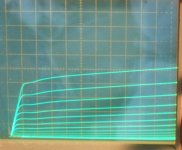 rsz_21hb5a_25vg2_10ma_10vdiv.jpg89.5 KB · Views: 66
rsz_21hb5a_25vg2_10ma_10vdiv.jpg89.5 KB · Views: 66 -
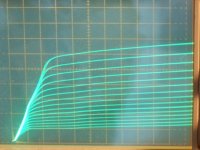 rsz_26lx6_50vg2_50ma_10vdiv.jpg116.7 KB · Views: 54
rsz_26lx6_50vg2_50ma_10vdiv.jpg116.7 KB · Views: 54 -
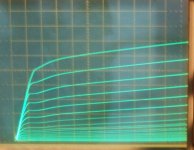 rsz_26lx6_25vg2_20ma_10vdiv.jpg94.1 KB · Views: 55
rsz_26lx6_25vg2_20ma_10vdiv.jpg94.1 KB · Views: 55 -
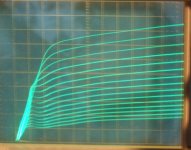 rsz_6dq5s_50vg2_20ma_10vdiv.jpg106.4 KB · Views: 58
rsz_6dq5s_50vg2_20ma_10vdiv.jpg106.4 KB · Views: 58 -
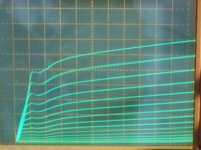 rsz_6dq5s_25vg2_10ma_10vdiv.jpg110.5 KB · Views: 70
rsz_6dq5s_25vg2_10ma_10vdiv.jpg110.5 KB · Views: 70 -
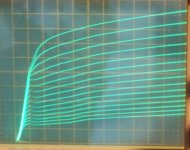 rsz_26dq5_50vg2_20ma_10vdiv.jpg101.8 KB · Views: 384
rsz_26dq5_50vg2_20ma_10vdiv.jpg101.8 KB · Views: 384 -
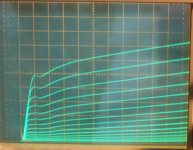 rsz_26dq5_25vg2_10ma_10vdiv.jpg129.5 KB · Views: 408
rsz_26dq5_25vg2_10ma_10vdiv.jpg129.5 KB · Views: 408 -
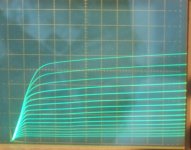 rsz_21hb5a_50vg2_20ma_10vdiv.jpg109.3 KB · Views: 62
rsz_21hb5a_50vg2_20ma_10vdiv.jpg109.3 KB · Views: 62
Last edited:
...I guess those are some real measurements on a 6DQ5.....
Sorry, no. I took a databook plot that YOU provided in #16, re-scaled the 6DQ5's lower-left corner to just the 26A7's area, traced the curve, and copied that over onto the 26A7 graph.
So it is only as "darn good" as some junior engineer in 1949 plotting a corner of the big-tube's graph that he knew nobody would ever need. (+/- my fat crayon and hasty tracing.) I think you say that your hot-glass tests show that these graph knee voltages are very approximate? I face a similar problem on 12AU7: they didn't even try to plot the low-low currents I want, because only a fool would care.
With all allowances for sweaty staff using lin-lin paper and fat drafting pens for clear reproduction-- yes, the sweep tube does seem quite useful at the low voltages. I have not looked at size, cost, heater power.
- Status
- This old topic is closed. If you want to reopen this topic, contact a moderator using the "Report Post" button.
- Home
- Amplifiers
- Tubes / Valves
- space charge tube preamp
